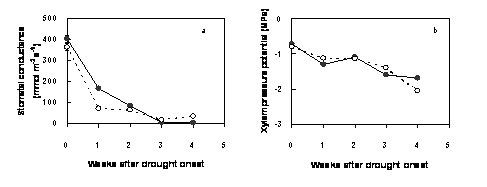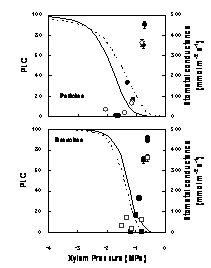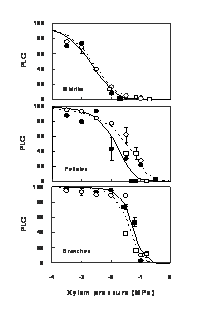
Xylem Embolism and Stomatal Regulation in Two Rubber Clones (Hevea brasiliensis Muell. Arg.) |
Rubber plantation in the non-traditional area (Northeastern part of Thailand) exhibits growth reduction, longer immaturity period and lower latex production compared as traditional area (Southern part) (Wichitchonchai and Manmeun, 1992; Manmeun et. al., 1993). In order to improve rubber cultivation in these area, more drought-efficient trees and adapted cultivation systems have to be developed. The understanding of rubber tree stomatal function is a key step in the under-standing of drought performance. Plant hydraulic characteristics, such as vulnerability to embolism might provide a sound basis for an early selection for drought-efficiency rubber trees. The objectives of this study were to test the hypothesis of a correlation between stomatal closure and cavitation avoidance Materials and Methods Experiment were conducted on 1 1/2 year-old rubber clones RRIM 600 and RRIT 251 during June-July 2002 at Department of Agronomy, Kasesart University, Bangkok, Thailand. The irrigation of one plant per clone was successively stopped at 1-week interval for induced soil dehydrati Minimum xylem pressure potentials were determined with a pressure chamber. Leaf stomatal conductance (gs) was measured with an AP4 Porometer.The percentage of loss of hydraulic conductivity (PLC) was measured at the end of the drought treatment on branches, petioles and midribs with the technique described by Sperry et. al. (1998) with a new XYL’EM apparatus.Vulnerability curves (VC) were constructed by dehydrating branches or leaves to different xylem pressure and measuring the corresponding PLC values.and to evaluate a potential variability of rubber tree hydraulic among different clones.
Figure 1 Xylem embolism meter (a), Pressure chamber (b) and AP4 Porometer (c). Table 1 Parameters of the logistic function fitted to the vulnerability curves. PPLC50 correspond to the xylem pressure (MPa) provoking 50% embolism and s is a slope parameter. For each clone, organs having a latter in common are not statistically different at p=0.05. Between clones, significant differences at p=0.1 are indicate by a *. Results and Discussion
Figure 2 Time course of leaf stomatal conductance (left) and xylem pressure potential (right) for RRIM 600 (close symbols) and RRIT 251 (open symbols) after pot watering was stopped at time 0.
Figure 3 Leaf stomatal conductance versus xylem pressure in the petiole and the branch of RRIM 600 (close symbols, plain lines) and RRIT 251 (open symbols, dotted lines).The lines are logistic fits of the vulnerability curves from figure 4.
Figure 4 Midribs, petioles and branches vulnerability curves for RRIM 600 (close symbols, plain lines) and RRIT 251 (open symbols, dotted lines) Circles correspond to air pressure-dehydrated sample and squares to measures on soil-dehydrated plants. Conclusions |
| คณะผู้วิจัย : Krissada Sangsing1,2, Poonpipope Kasemsap2, Sornprach Thanisawanyangkura3, Kumut Sangkhasila4, Eric Gohet5, Phillipe Thaler5 and Herve Cochard6 หน่วยงาน 1Rubber Research Institute, Department of Agriculture, Bangkok, Thailand 2Department of Agronomy, Faculty of Agriculture, Kasetsart University, Bangkok, Thailand 3Department of Botany, Faculty of Science, Kasetsart University, Bangkok, Thailand 4Department of Soil Science, Faculty of Agriculture, Kasetsart University, Bangkok, Thailand 5Cirad-cp Rubber Program, Doras Center, Kasetsart University, Bangkok, Thailand 6UMR-PIAF, INRA, Site de Crouelle, 63039 Clermont-Ferrand, France |



